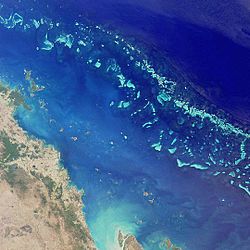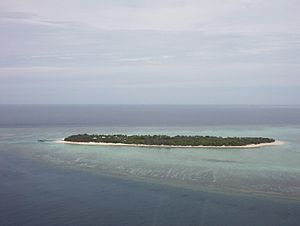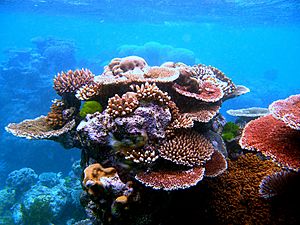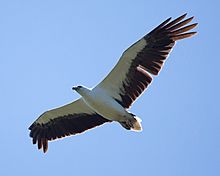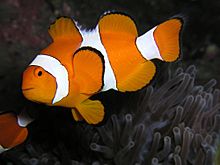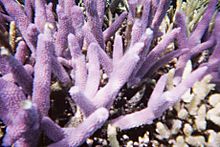Great Barrier Reef facts for kids
| UNESCO World Heritage Site | |
|---|---|
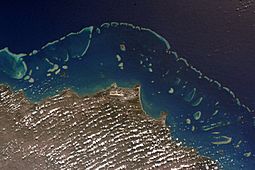
Image of part of the Great Barrier Reef adjacent to Queensland, taken from the International Space Station
|
|
| Location | Off the east coast of the Queensland mainland, Australia |
| Criteria | Natural: vii, viii, ix, x |
| Inscription | 1981 (5th Session) |
| Area | 34,870,000 ha (86,200,000 acres) |
 Locator map of the protected area |
|
The Great Barrier Reef is the world's largest coral reef. This reef structure is composed of and built by billions of tiny organisms, known as coral polyps. It is the largest structure made by living things.
The Great Barrier Reef supports a wide diversity of life and was selected as a World Heritage Site in 1981.
The biggest threat to the Great Barrier Reef today is coral bleaching caused by high sea water temperatures as a result of global warming.
Contents
How big is it?
The Great Barrier Reef is so big, it can even be seen from space! Here are some mind-blowing facts about its size:
- It stretches over 2,300 kilometers (1,430 miles). That's longer than the entire coastline of Italy!
- It covers an area of about 344,400 square kilometers (133,000 square miles). That's bigger than Japan!
- The reef is made up of over 2,900 individual reefs, 600 islands, and 300 coral cays.
How was it formed?
The Great Barrier Reef started forming a very, very long time ago – about 20,000 years ago! It all began when tiny animals called coral polyps started building their homes on the shallow ocean floor.
Tiny architects
Coral polyps are small, soft-bodied creatures, and they're the master builders of the reef. Each polyp is like a tiny tube with a mouth at the top, surrounded by tentacles. These tentacles help them catch tiny bits of food floating in the water.
But here's the cool part: coral polyps can build a hard, protective skeleton around themselves using minerals from the seawater. These skeletons are made of [[[calcium carbonate]], which is the same stuff that makes up chalk and limestone.
As the polyps grow and multiply, they build more and more of these skeletons. Over thousands of years, these skeletons accumulate and form the massive structures we know as coral reefs.
Rising Sea Levels
During the last Ice Age, the sea levels were much lower than they are today. As the Earth started to warm up, the ice melted, and the sea levels rose. This flooded the coastal areas and provided the perfect conditions for coral polyps to thrive.
The rising sea levels allowed the coral polyps to spread and build their reefs on the submerged land. Over time, the reefs grew upwards and outwards, creating the vast and complex system that we see today.
Rainbow of colors
One of the most amazing things about the Great Barrier Reef is its incredible colors. Corals come in all sorts of shades, from bright pinks and purples to vibrant yellows and greens.
But where do these colors come from? Corals have a special relationship with tiny algae called zooxanthellae (say: zoo-zan-THEL-ee). These algae live inside the coral tissues and provide the coral with food through photosynthesis, just like plants do on land. In return, the coral provides the algae with a safe place to live.
The zooxanthellae are also responsible for the corals' vibrant colors. Different types of algae produce different pigments, which give the corals their unique hues.
History
The Aboriginal and Torres Strait Islander peoples have lived in the area for at least 60,000 years and have a deep connection to the reef. They use the reef for food, medicine, and cultural practices.
In 1770, Captain James Cook, a British explorer, sailed along the coast of Australia and charted the Great Barrier Reef. He was one of the first Europeans to see the reef, and he named many of its islands and features.
Ecology
The Great Barrier Reef has 1,500 species of fish, and many other animals, algae, and corals. This includes many vulnerable or endangered species. Some of these exist only on this reef system.
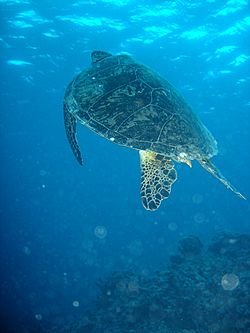
Mammals
Thirty species of whales, dolphins, and porpoises have been seen in the Great Barrier Reef. This includes the dwarf minke whale, Indo-Pacific humpback dolphin, and the humpback whale. Most of the population of the dugongs live there.
Turtles and Dugongs
Six species of sea turtles come to the reef to breed. These are the green sea turtle, leatherback sea turtle, hawksbill turtle, loggerhead sea turtle, flatback turtle, and the olive ridley. There are two different groups of green sea turtles on the Great Barrier Reef. One group lives in the northern part of the reef and the other in the south. Fifteen species of seagrass attract the dugongs and turtles. They also provide a food and shelter for fish. The most common kinds of seagrasses are Halophila and Halodule.
Other sea animals
Saltwater Crocodiles live in mangrove and salt marshes on the coast near the reef. No crocodile nests have been found on the reef. The salt water crocodiles on the reef travel long distances. There are not many living around the reef. Around 125 species of shark, stingray, skates or chimaera live on the reef. About 5,000 species of mollusc live on the reef. These include the giant clam, nudibranchs and cone snails. Forty-nine species of pipefish and nine species of seahorse have been found. Seven species of frogs live on the islands.Also, the Moray eel lives on the bottom, preying on fish.
Birds
215 species of birds come to the reef or nest or roost on the islands. This includes 22 species of seabirds and 32 species of shorebirds. These include the white-bellied sea eagle and roseate tern. Most nesting sites are on islands in the northern and southern regions of the Great Barrier Reef. About 1.7 million birds use the sites to breed.
Plants
The islands of the Great Barrier Reef have 2,195 known plant species. Three of these do not live anywhere else. The northern islands have 300-350 plants which are woody. The southern islands have 200 plants which are herbaceous. The Whitsunday region has the most plant species placing at 1,141. The plant species are mostly spread by fish
Sea snakes
Seventeen types of sea snake live on the Great Barrier Reef. They take about 4 years to become old enough to breed. They usually live on the sea floor. They live in warm waters up to 50 metres (160 ft) deep. They are more common in the southern part of the reef.
Fish, ascidians and bryozoans
More than 1,500 species of fish live on the reef. These include the clownfish, red bass, red-throat emperor, and several types of snapper and coral trout. There are at least 330 species of sea squirts (ascidians) on the reef. These vary in size from 1 mm-10 cm in diameter. Between 300-500 species of bryozoans live on the reef system. These are small water animals that look like moss, or branches
Corals
Four hundred species of corals, both hard corals and soft corals live on the reef. Most of these spawn, releasing thousands of eggs, in huge events. This spawning is controlled by the rising sea temperatures. This happens in spring, summer and some parts of autumn, as part of the moons lunar cycle, and the day/night diurnal cycle. Reefs in the inner Great Barrier Reef spawn during the week after the full moon in October. Outer reefs spawn in November and December. The common soft corals on the Great Barrier Reef belong to 36 different types. Five hundred species of marine algae or seaweed live on the reef. This includes thirteen types of Halimeda. These deposit chalky (calcareous) mounds up to 100 metres wide. They have mini-ecosystems on their surface which have been compared to rainforest cover.
Climate change
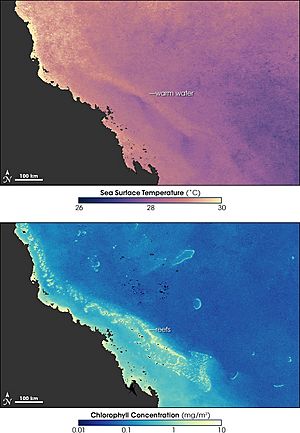
A new report, the Reef Outlook Report, says that climate change will cause huge damage to the reef. The report was written by the Great Barrier Reef Marine Park Authority. Warmer and more acidic water around the coral reef will slow down calcification, which is how the coral grows and becomes strong. The corals will become bleached (lose their colours) and many species that live on and around the reef will be in danger. The Australian government has already spent AU$325 million to improve the health of the reef in the last two years.
Other dangers
The Reef Outlook Report also warned of other dangers to the reef. These included poor quality water running into the sea from the mainland. This water is polluted with farm insecticides and rubbish from nearby towns. The increasing amount of development on the coast is destroying natural marine and coastal habitats. There is also some damage from fishing.
Fun facts about the Great Barrier Reef
- The Great Barrier Reef is bigger than Italy, Japan, or Germany.
- It's home to over 30 species of whales, dolphins, and porpoises.
- Some of the coral in the reef is over 8,000 years old!
- It was Matthew Flinders who named the Great Barrier Reef, after his more detailed mapping of it in 1802.
- The Reef Research Center has found the remains of coral that are half a million years old. Corals have been growing in the region for as long as 25 million years.
Related pages
Images for kids
-
Heron Island, a coral cay in the southern Great Barrier Reef
-
A striped surgeonfish amongst the coral on Flynn Reef
-
A scuba diver looking at a giant clam on the Great Barrier Reef
See also
 In Spanish: Gran Barrera de Coral para niños
In Spanish: Gran Barrera de Coral para niños


